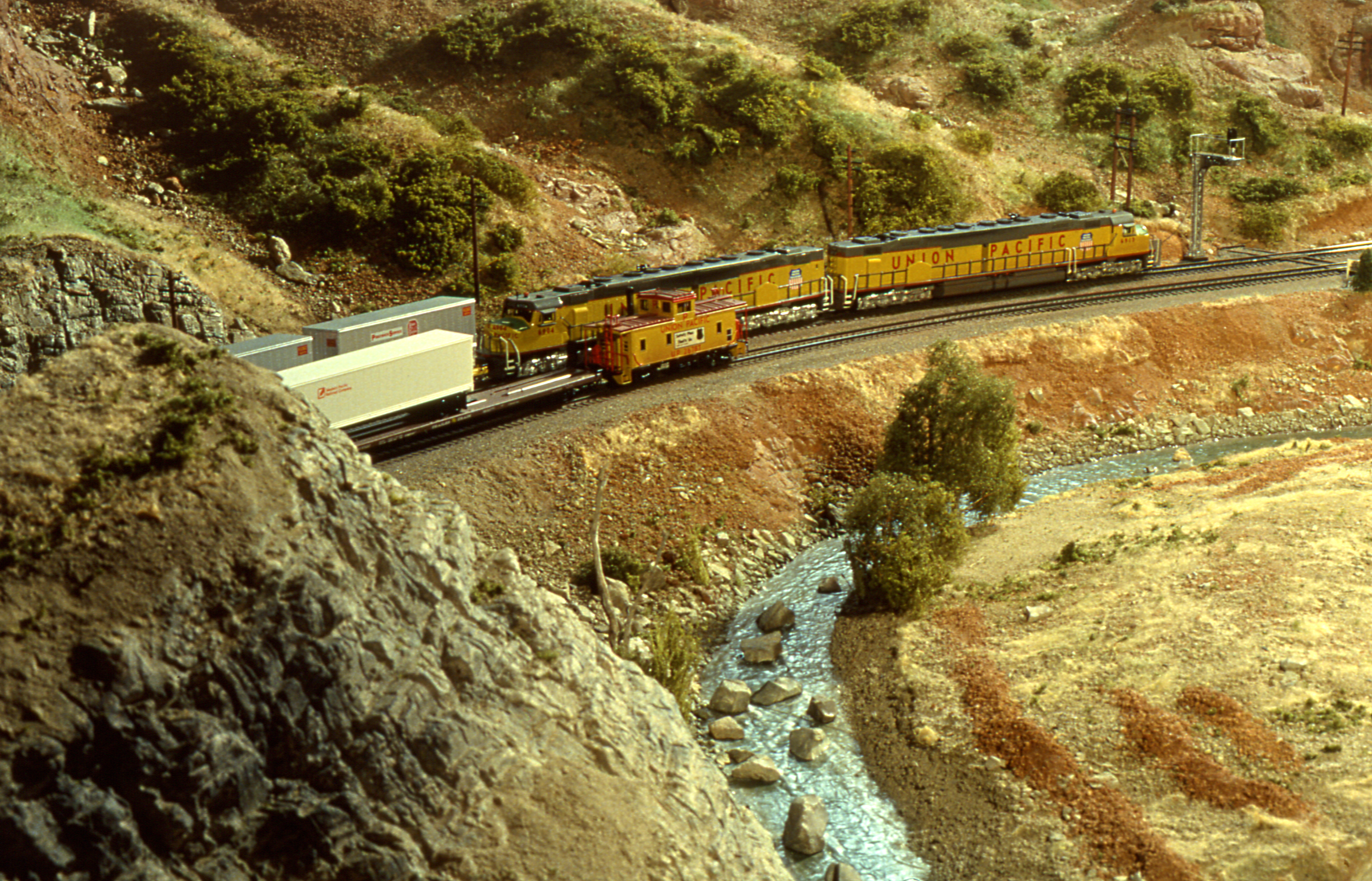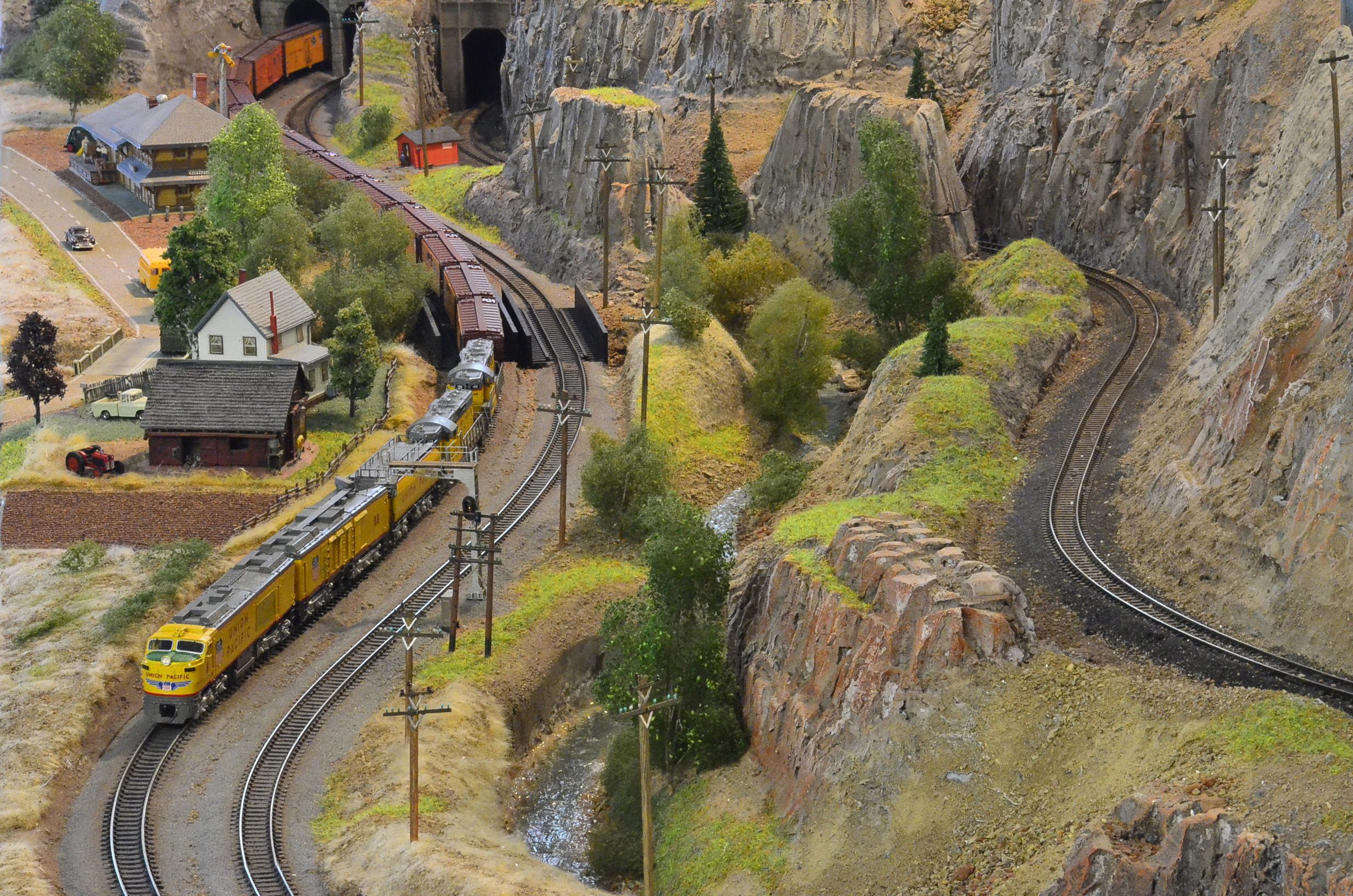I've used a couple of techniques for small rivers that have worked quite well.
The first technique was to not create an actual river "bed", but I used Foamcore for the "bed" and built up the river's edges from plaster and real rock rip-rap.
I then airbrushed the colors of the small river (the Weber River in Weber Canyon) using reference photos I took of the spot I was modeling. Although the Weber River is clear in the Summer, Fall and Winter, it gets reddish brown during the Spring runoff. I was modeling the early Summer, so it was clear by that time. There were lots of rocks in the stream at the location I was modeling (Wilhemina Pass and Devils Slide), however, the river fills up with freshwater weeds, which are long (over 20' long) and wave along as the current passes over them. The bottom of the river is also covered in weeds but a different kind and the impression you get when you look at the river is that the edges are "wavy" green, which fades to a greenish-black in the channel. There's also a very thin edge where you can see the sand and stones along the sides, but it's a greenish tint...very light, which gets darker as it blends into the waving weeds, then it goes rather quickly to a greenish black.
Where the river curves, the inside of the curve almost always has a sand/mud bar, and the outside edge of the curve runs along a steep embankment. I modeled both of those items, and implied the sand/mud bar with a darker, greenish tinted color for the underwater parts. I also airbrushed lighter "spots" in parts of the river where big rocks had fallen off the cliff and were under water or still sticking out.
All this painting was done on a perfectly flat surface, just implying the colors of the river with no depth whatsoever.
Next, I applied two coats of gloss gel, the first one was painted smoothly on, the second coat was manipulated so it had some ripples and waves in it, then I applied more ripples and waves around rocks and logs and bridge abutments.
Next, I mixed up a bit of Titanium White with more gloss gel (not opaque, but translucent) and started working on the white caps...building them up and letting each application dry.
Then I added some full-strength Titanium white to the really rough white caps and when that dried, I painted those flat white spots with a coating of gloss medium (not gel).
I was quite amazed at the depth your eye tricks you into thinking you see. I had many comments from visitors and fellow modelers who swore that I'd used a fancy resin technique instead of just creating a rough shiny surface over paint.
Second technique was to actually make a river bed, paint it much like I did to the Foamcore river, but put a layer of Envirotex on it...about a 1/4" layer.
What I absolutely HATE about Envirotex (other than the smell) is how it creeps up on to rocks, twigs and river banks, so I did just the bare minimum of scenicking along the river sides, but I did insert big rocks where appropriate, and build actual sand/mud bars that got covered up with the resin.
Envirotex self-levels so you have to keep adding it until it's at the level you want. It will also find any little hole and leak like crazy all over your floor, so make sure you've got the holes plugged.
You inevitably get a lot of bubbles when you pour it. You can use a propane torch to lightly (very lightly please) apply a flame close to, but not touching the still liquid resin. The bubbles come right up and disappear. Another method is to use a long straw and blow on your still liquid river. This works well too, except it stinks and you get spit on the surface of your "water". Don't worry, it doesn't affect the hardening process.
After the resin has cured to a glass-like smooth surface, add your thin river banks (right over the resin that has crept up the sides) and paint the boulders in the water which will be nearly encased with the creeping resin.
After your river banks are dry, do all of what I wrote above to the glass smooth surface of your river, using gloss medium, glossy gel medium (thick and thicker) or WS "Water Effects" for big rapids and waves.
This makes for a really excellent watery look for rivers and lakes.
Here's a photo of my Weber River I did for my first Wilhemina Pass/Devils Slide attempt over Foamcore with various thicknesses of gloss medium:

Here's another view:

Here's a distant shot of the river on the Ntrak 2000 modules done using a layer of Envirotex with gloss medium of different viscosities texturing the surface:

Here's a photo of a small river I did for my friend Nate's Riverside scene on his home layout. This was done using gloss medium and WS Water Effects over a flat Foamcore base:

I haven't done raging rapids or waterfalls yet. There are some real experts here that may show their work if that's what you want also.
Just like most of what I do, I approach everything I build for my model railroad as a model, which gets researched and photographed before I start building...including the rivers. If I'm asked to build scenery for someone else, it usually ends up looking like what I've researched.